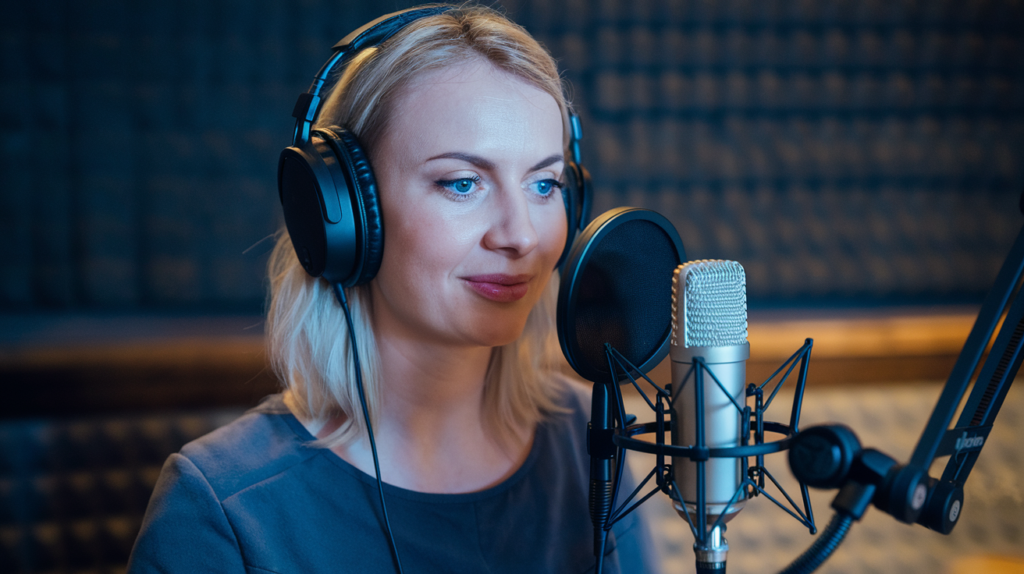Key Takeaways
- Cultural Bridge: The Polish language serves as a vital link in global media, enhancing cross-cultural communication through journalism, film, and social media.
- Historical Influence: Understanding the evolution of Polish media—from its origins to the digital age—provides insight into its significant contributions to international storytelling.
- International Representation: Polish narratives are increasingly recognized on global platforms, with filmmakers gaining awards and attention for their culturally rich stories.
- Role of Voiceovers: High-quality voiceovers are essential for making Polish content accessible to non-Polish speakers while preserving cultural nuances in translations.
- Challenges Ahead: Language barriers and globalization present challenges for Polish-language media; however, authentic storytelling can still resonate with diverse audiences.
- Future Opportunities: The growing demand for Polish content on streaming services and social media highlights potential growth avenues through collaboration and innovative formats.
Ever wondered how the Polish language shapes global media? As the world becomes increasingly interconnected, languages play a crucial role in bridging cultures and sharing stories. The Polish language isn’t just a means of communication; it’s a vibrant thread weaving through international journalism, film, and social media.
In this digital age, understanding the impact of Polish on global platforms can unlock new perspectives and opportunities. Whether you’re a content creator looking to reach wider audiences or simply curious about cultural influences, recognizing Poland’s linguistic contributions is essential. Dive into the fascinating ways Polish resonates across borders and discover why it matters more than ever in today’s media landscape.
Overview of Polish Language in Media
Polish plays a crucial role in global media, serving as a bridge among cultures. The language’s presence spans various platforms, including journalism, film, and social media. In journalism, Polish news outlets cater to both local and international audiences, offering insights into current events from a unique perspective.
In film, Polish cinema has gained recognition on the world stage. Directors and screenwriters create compelling narratives that resonate with diverse viewers. With awards like the Oscars acknowledging Polish films, this cultural export continues to shape perceptions beyond Poland’s borders.
Social media also highlights the significance of Polish. Users share content in their native tongue while engaging with global topics. This interaction fosters community connections and allows for broader discussions about culture and identity.
Voiceovers contribute significantly to how Polish-language media is consumed internationally. By providing localized content through skilled voice actors and artists, producers ensure that narratives reach wider audiences effectively. Voice talent enhances understanding by delivering authentic performances that capture the essence of the original material.
As you explore these dynamics within global media, consider how the Polish language influences storytelling and audience engagement across platforms.
Historical Context
The Polish language boasts a rich history that significantly influences global media today. Understanding its development provides insight into how it connects cultures through various forms of communication.
Development of Polish Media
Polish media emerged in the late 19th century, driven by national movements and a desire for cultural expression. The establishment of newspapers, such as «Czas» and «Kurier Warszawski,» marked the beginning of organized journalism in Poland. These outlets played crucial roles in informing the public and shaping national identity. With advancements in technology, radio and television further expanded Polish media reach, allowing voices to resonate beyond borders.
As globalization progressed, the demand for Polish-language content increased. This growth spurred collaboration between local creators and international platforms, creating opportunities for diverse storytelling that appeals to wider audiences. Voiceover talent became essential during this transition, facilitating access to Polish narratives while maintaining authenticity.
Key Milestones in Media Evolution
Several key milestones define the evolution of Polish media:
- First Newspapers (18th Century): The introduction of printed materials laid the foundation for modern journalism.
- Radio Broadcasting (1925): Radio connected communities and provided immediate news coverage.
- Television Launch (1952): Television transformed entertainment consumption with visual storytelling.
- Post-Communism Era (1989): Media liberalization led to an explosion of independent outlets and diverse perspectives.
- Digital Revolution (21st Century): Online platforms enabled widespread distribution of Polish content globally.
These milestones illustrate how each phase contributed to shaping a vibrant media landscape where Polish serves as a bridge among cultures, fostering cross-cultural dialogue through various formats including film and social media discussions centered around identity.
In this context, voiceovers play an integral role by enhancing accessibility for international audiences who seek authentic experiences with Polish-language content. As you explore these historical developments, consider how they inform current practices within the global media landscape today.
Current Impact of Polish Language
Polish language plays a significant role in global media, influencing various platforms and connecting cultures. Its presence enhances storytelling and audience engagement across diverse formats.
Representation in International Media
Polish-language content has gained traction in international media, with films and television shows featuring Polish narratives. Notable directors have showcased their work on global stages, earning awards that highlight the depth of Polish storytelling. With increasing interest from audiences worldwide, the representation of Polish culture is becoming more pronounced. This growth opens doors for collaborations between local creators and international productions, allowing rich cultural exchanges.
Polish Language in Digital Platforms
Digital platforms provide a vibrant space for the Polish language to flourish. Social media users actively engage in discussions about their culture while sharing content uniquely crafted for them. Streaming services also feature an expanding library of Polish films and series, amplifying this dynamic presence. Voiceovers play a key role here; they enhance accessibility by allowing non-Polish speakers to experience these narratives authentically. By employing skilled voice actors who understand the nuances of the language, creators ensure that stories resonate with a broader audience while preserving their cultural essence.
The current impact of the Polish language within global media reflects its importance as a connector among cultures through representation in international outlets and vibrant digital platforms.
Challenges Facing Polish Language Media
Polish language media encounters several challenges that impact its growth and reach. These obstacles can hinder the effectiveness of content delivery and audience engagement.
Language Barriers and Accessibility
Language barriers pose significant challenges for Polish language media, especially when aiming to connect with non-Polish-speaking audiences. While the demand for diverse narratives is growing, many international platforms lack adequate Polish-language content. Voiceovers play a crucial role in bridging this gap, offering translated versions of films, documentaries, and shows without losing their original essence. High-quality voice talent ensures that cultural nuances remain intact during translation, making it easier for global viewers to appreciate Polish stories. Without effective voiceover solutions, valuable content risks being overlooked by broader audiences.
Globalization and Cultural Identity
Globalization further complicates the landscape for Polish language media. As more creators share their work internationally, maintaining cultural identity becomes paramount. The influx of foreign media influences how local creators shape their narratives. However, polish filmmakers and journalists often strive to preserve authentic voices even amid these pressures. Engaging storytelling rooted in Polish culture resonates deeply with both local and global audiences when done right; this creates opportunities for rich exchanges while highlighting unique perspectives.
In navigating these challenges, embracing innovative strategies is essential for the future of Polish language media. By leveraging tools like voiceovers alongside authentic storytelling techniques, you can help elevate the presence of Polish narratives on the world stage.
Future Prospects
The future of the Polish language in global media looks promising, with evolving trends and growth opportunities on the horizon.
Trends in Polish Language Media
Emerging trends showcase a growing interest in Polish-language content across various platforms. Streaming services increasingly feature Polish films and series, reflecting a demand for diverse narratives. Social media engagement is soaring as users share culturally rich content, fostering dynamic discussions. Voiceovers play a pivotal role here; they enhance accessibility to these narratives while ensuring that cultural nuances resonate with audiences worldwide. As more creators recognize the importance of high-quality voiceover talent, expect an increase in projects that prioritize authentic representation.
Opportunities for Growth
Numerous opportunities await those involved in Polish-language media. The rising collaboration between local filmmakers and international producers enables cross-cultural storytelling that captivates broader audiences. By leveraging voiceover artists skilled in conveying emotion and authenticity, projects can transcend language barriers effectively. Expanding access to educational resources around voice acting and production techniques can further empower aspiring creators. Additionally, as digital platforms continue to evolve, embracing innovative formats like podcasts or web series offers fresh avenues for exploring Polish culture and identity through compelling narratives.
The intersection of technology and creativity undoubtedly positions the Polish language as an influential player within global media landscapes moving forward.
Conclusion
The Polish language’s role in global media is undeniable. Its ability to connect cultures through journalism film and social media enriches the international landscape. As you explore this dynamic environment you’ll find that Polish narratives are gaining traction and resonating with broader audiences.
Embracing emerging trends like streaming services and innovative formats can lead to exciting opportunities for creators. The importance of high-quality voiceovers cannot be overstated as they bridge gaps between languages while preserving cultural integrity.
By recognizing these developments you’re not just engaging with a language but participating in a vibrant cultural exchange that continues to evolve. The future of Polish-language content looks bright inviting everyone to appreciate its unique contributions on the world stage.
Frequently Asked Questions
What is the significance of the Polish language in global media?
The Polish language plays a crucial role in global media by connecting cultures through journalism, film, and social media. It offers unique perspectives on current events and enhances storytelling across various platforms, fostering cultural exchanges.
How has Polish media evolved over time?
Polish media has evolved significantly since its inception in the late 19th century. Key milestones include the introduction of printed materials, radio broadcasting in 1925, television launch in 1952, and digital advancements post-1989 that expanded access to content.
What challenges does Polish-language media face today?
Polish-language media faces challenges like language barriers for non-Polish speakers and limited availability of content on international platforms. Additionally, globalization often influences local narratives, making it essential for creators to maintain authentic voices.
How do voiceovers enhance Polish-language content?
Voiceovers are vital for making Polish-language content accessible to non-Polish speakers while retaining cultural authenticity. They bridge language gaps and ensure that stories resonate with diverse audiences globally.
What opportunities exist for the future of Polish-language media?
The future looks promising with increasing interest in Polish films and series on streaming services. Collaborations between local filmmakers and international producers can enrich cross-cultural storytelling, while innovative formats like podcasts offer new avenues for exploration.







